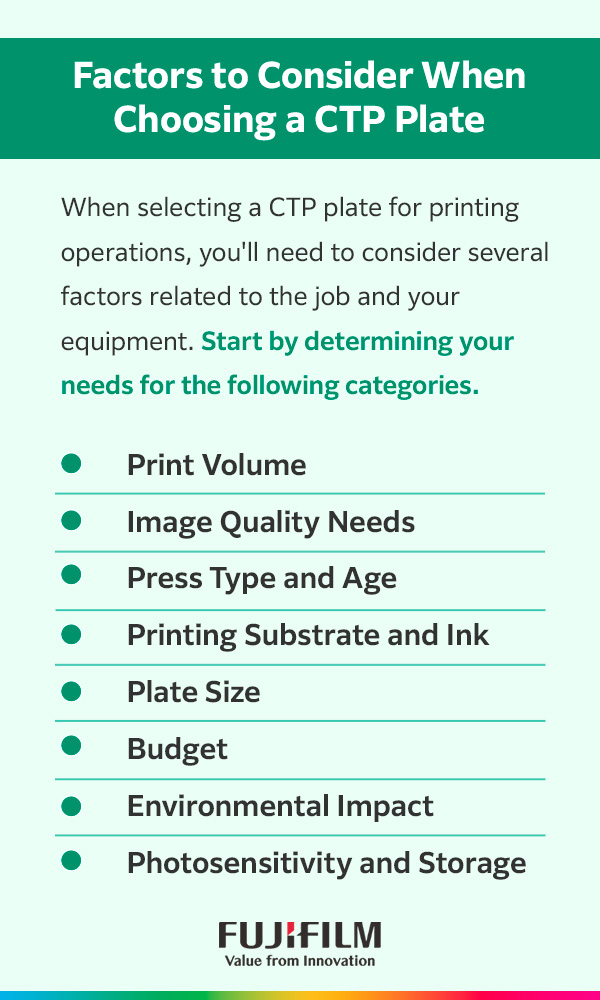A crucial component of commercial offset printing is computer-to-plate (CTP) technology. It enables image reproduction from a computer file onto a physical plate, and your CTP selection can impact your final print quality and speed. With so many options and variables, determining the best plate isn’t always straightforward.
The right plate for your operation will depend on many factors, like the characteristics of your print jobs and press. If you know what to look for, you can get CTP plates for offset printing that fit your budget, environmental goals, and speed and quality demands.

When selecting a CTP plate for printing operations, you’ll need to consider several factors related to the job and your equipment. Start by determining your needs for the following categories.
The size of your print run will affect how long you need the plate to last. Thermal plates are typically more durable than violet plates, so they can stand up to longer runs without degrading and requiring a second plate. This feature can help make prints more consistent. The platesetting process is also highly repeatable, improving the consistency between two plates.
While both CTP plates can offer great quality, thermal plates have the edge over violet ones. They usually provide sharper details and precise dot reproduction for a high-quality image. The thermal imaging process is often more sensitive and offers finer dot reproduction for sharper details.
You can use either CTP plate with many kinds of printing presses, but you must confirm that the plate you want is compatible with your press. Web and sheet-fed printing presses use format sizes. Your CTP plate must accommodate these differences.
CTP plates come in various configurations, some of which work better for certain substrates and inks. While neither thermal nor violet plates outperform the other in all scenarios, you must evaluate your ink formulations, substrate adhesion and other properties. For example, our Superia thermal plates offer excellent UV printing, while our plate has superior chemical resistance. Look for plate characteristics that align with your substrates and ink.
Of course, the size of your plate must match the size of your. Both types of plates come in varieties designed for large and small formats, but plates.
While neither thermal nor violet plates use the same chemicals as conventional plates, some products require chemicals during processing. However, process-free plates are also common. These plates don’t use any chemicals. They minimize pollution risks and disposal requirements, making them a more sustainable solution.
You can also examine the environmental impact from an energy perspective. During imaging, a platesetterenergy to power an ultraviolet or thermal laser.

Understanding which plate type you need is only one part of the equation. You’ll still need to find the right products for your operation. Low-quality plates can easily hinder your success. At Fujifilm, we offer a large selection of industry-leading thermal, violet and conventional CTP plates, and our knowledgeable representatives can match you with the right products.
Here are some details about our lineups and how they support different CTP plate demands.
Many of our high-performing thermal plates come from the SUPERIA collection. Options include:
Our other thermal plates can help you meet various goals, like more sustainable printing, longer print runs and improved quality.
In addition to plates, we offer several CTP platesetters.
Whatever your commercial print needs are, the right CTP plate is critical. Hopefully, you now have a better idea of what type of plate you need and how it affects other elements of your printing operation. Whether you know what you need or you still have questions, our knowledgeable team can help you take the next steps. We’ll ask a few questions about your system and needs and find CTP plates that fit the bill.
Fujifilm has been an industry leader in printing for decades, with the expertise and technology to support diverse print demands. Contact us today to learn more about our CTP capabilities.